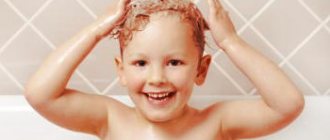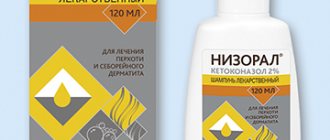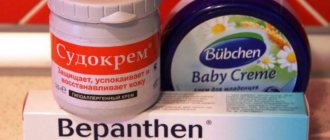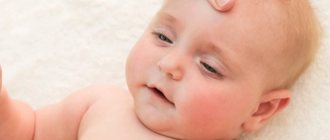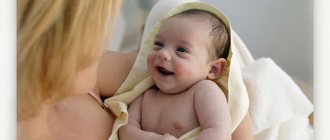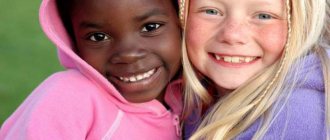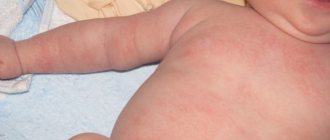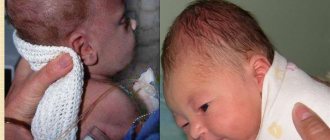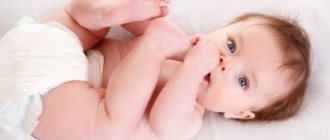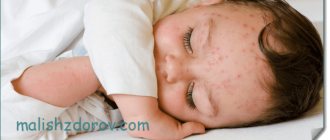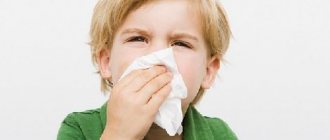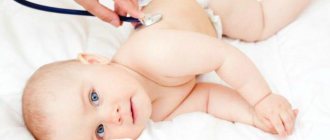Already in the first weeks of a newborn’s life, small yellow crusts can be seen on his head or in the upper part of his face, greasy to the touch and completely unaesthetic from a visual point of view. This is a seborrheic crust, also called “milk crust” or “cradle cap”.
This phenomenon, characteristic of every third baby, is practically harmless and is in no way related to the child’s health or lack of hygiene. Even if you do nothing with them, in the vast majority of babies the crusts completely disappear on their own by 9-12 months . However, the main problem with seborrheic crust is that it is not aesthetically pleasing. In addition, it may contain bacteria or fungus.
Therefore, most parents prefer to get rid of them as soon as possible.
Crust on the head of a baby, reasons
a baby with a short haircut for combing out crusts
The process of adapting a baby to the air environment is associated with the restructuring of all systems to operate in a different mode. In particular, the sebaceous and sweat glands begin to function more actively, which leads to the accumulation of the products of their work on the baby’s scalp. After a short period of time they harden.
Outwardly, it looks like white or yellow scales accumulated in the area of the fontanel or throughout the baby’s head. Such a crust causes great concern to young parents, but not to the baby himself.
It should be noted that it manifests itself in almost every newborn child and goes away on its own by the first year of his life.
In medicine, a white scaly coating on the head of a baby is called seborrheic dermatitis, but it has nothing to do with this disease.
The reasons for the formation of a crust in a baby, in addition to the active work of its sebaceous glands, are as follows:
- During breastfeeding, the mother ignores recommendations for her diet and consumes smoked foods, canned food, and chemical seasonings.
- dressing the baby in clothes that are too warm, especially of synthetic origin, which creates a greenhouse effect on his skin
- violation by young parents of recommendations for maintaining a special microclimate in the nursery - too hot and dry
- wearing a hat for a long time by a child, including one made of chemical fiber
- excessively frequent water procedures with the baby
- presence of allergic reactions, diathesis
- the use of children's cosmetics with fragrances, dyes and aggressive chemical compounds
Is gneiss a disease?
There is no need to blame a young mother for careless care of her baby. Gneiss is a physiological phenomenon, the causes of which lie in the imperfect functioning of the sebaceous and sweat glands, or more precisely, in their disharmonious work.
It may not go away for a long time if the child’s scalp is not properly cared for and there is a tendency to allergic reactions.
Typically, gneiss on the scalp is most noticeable on the crown, in the fontanelle area, and may even be on the baby’s forehead and eyebrows. The child’s mother, frightened by such a sight and the belief of some people that her child’s hair will not grow, can, of course, immediately go for a consultation with a pediatrician. However, before visiting a doctor, you can try to figure out the causes of the nasty lep yourself.
Looking for reasons
1. For excessive fear of drafts and hypothermia, parents put a hat on their baby, even at home. This leads to even more sweating of the head and the appearance of more and more milky crusts.
2. The baby’s delicate skin is quite vulnerable. Cosmetics containing fragrances and dyes can also provoke various skin reactions. It is necessary to avoid cosmetics with bright colors and strong odors. And of course, never use shampoos for adults.
3. Daily water procedures with washing your hair will most likely lead to dry scalp. As a result, the work of the sebaceous glands will intensify, and the number of yellow crusts will only increase.
4. Strange as it may sound, the cause of the appearance of gneiss may also be the introduction of complementary foods. Mostly, such reactions occur in children prone to allergies.
Having analyzed the correctness of caring for the baby, and having understood your mistakes, it is still worth starting to rid the small head of unnecessary layers. You shouldn’t wait for the gneiss on your head and eyebrows to go away on its own. Lack of proper scalp care can lead to prolonged seborrhea and the child’s crusts will remain until the age of 4 or even 7 years and will require consultation with a dermatologist. With proper care, the dark crusts gradually disappear by the second year of the baby’s life.
You should not use drastic methods of removing the crust, trying to pick and rip off the scales using nails or other objects. This can injure the delicate skin, causing a lot of anxiety for the baby.
What to do with a crust on a baby’s head?
the baby is bathed to remove crusts from the head
- Since the presence of crusts on the baby’s head does not cause him any concern and is not a skin disease, it would seem there is nothing to worry about
- But young parents are not aesthetically happy to see such “dandruff” on their child. And the public opinion that it is harmful and interferes with hair growth puts pressure on them. However, this is a misconception, proven in practice, that there is no relationship between the growth rate of hairs on the baby’s head and the presence of scaly growths
- The only method is mechanical cleansing. It is carried out with a special soft brush with natural bristles, after softening and steaming the crusts on the baby’s head
- Note that some parents still allow the baby’s sebaceous glands to adapt to the air environment and regulate their activity without any intervention. Therefore, they do not focus on the crusts and do not torment the baby by combing them out
Methods of disposal
To get rid of scaly formations on a baby’s head, you need to carefully prepare for this process.
IMPORTANT! It must be remembered that in no way should you rush to comb out or try to peel off the crusts. This is fraught with serious consequences.
- The first thing you should do is prepare some kind of softening agent (olive oil, special shampoo, baby soap, burdock oil), a soft brush (you need to pay attention to the fact that its bristles are made of natural fibers), and a cotton baby hat.
- Next, you need to apply the prepared product to the scalp of the newborn. It should be applied as carefully as possible so as not to damage the baby's skin. You can use cotton wool for this. After you have applied the moisturizer, put a cap on the baby's head, and after an hour or two, just carefully rinse everything off while bathing the baby.
- After bathing, you should comb out all the crusts from the baby’s head as carefully as possible.
- If a few crusts still remain on your baby’s head, then don’t be upset, because most likely they will be washed off during the next bath.
- If the procedure does not bring the expected result, then you can anoint the child’s head with oil, put on a cap and leave it overnight.
- Remember that this method can be repeated no more than once a week, and even if your child’s scales have disappeared, this method can be an excellent preventative measure, since crusts tend to form again.
Treatment of a crust on the head of a baby
baby in the bathroom before combing out the crusts
As noted above, it is not necessary to undertake any special treatment for scaly formations on the baby’s head. This is just a physiological reaction of his body to a change in habitat.
On the other hand, young parents can easily track the prerequisites and causes that cause the appearance and growth of crusts, and eliminate them.
Preventative measures for scaly white/yellow plaques are as follows:
- cleanliness and humidification of the children's room. Buy a special device to maintain a stable percentage of humidity in the nursery
- dressing according to the season and indoor climate conditions
- air baths for both the baby’s entire body and his head
- refusal of any synthetic clothing for babies
- strict adherence to the diet of a breastfeeding mother
- elimination of products and environmental factors that cause allergic reactions and rashes on the baby’s skin
Treatment
If there is a fear of harm when independently ridding a newborn of postpartum dirt on the head, it is advisable to consult a pediatrician. The pediatrician will prescribe medicated shampoo and lotion for the disease, or mechanical methods of removing crusts will suffice.
How to remove birth dirt from a child’s head:
- removing scales with your fingers, without using tweezers or sharp objects;
- lightly rubbing the scales and then combing out the rough skin;
- using thin gloves, you should make sure in advance that the child does not have an allergic reaction to the material;
- Washing your hair daily with warm water in the bath to soften the skin.
Shampoos. In order to remove birth dirt from a child’s head, baby shampoos are purchased and sold at pharmacies without special prescriptions. The products contain active substances that combat dry skin and flaking. After purchasing medicated shampoo, washing is carried out in 3 stages.
How to comb out the crust from the scalp of infants with oil?
mother combs crusts from the baby’s head with a brush.
If you decide to eliminate an aesthetic defect from the baby’s head and hairs, then prepare:
- natural oil, such as refined olive or burdock
- fragrance-free and paraben-free baby soap
- brush with soft natural bristles
- thin cotton hat for baby
Then follow these steps in order:
- Lubricate the crusted areas on the head with oil. To avoid causing harm or distress to the child, do this with a cotton swab dipped in oil.
- if the crusts are thin and white, leave the baby’s head uncovered; if they are thick and yellow, put on a cap for half an hour
- use the brush to gently move in different directions over the area with crusts
- water procedures. Gently wash your baby's head with your fingers and soap
- Gently pat your baby's head dry with a towel after bathing
- You can go through the brush again to remove the remaining combed crusts from the baby’s hairs
The frequency of such procedures should not be more than twice every seven days. Note that you should also not wash your baby’s hair more frequently, even with the use of baby soaps, shampoos, and gels.
Caring for a crust on a baby's head
baby in the bathroom with wet hair before combing out the crusts
- Milk crust is a common and expected phenomenon in infants, but young parents should not completely ignore its presence.
- Doctors say that crusts on a child’s head are an indicator of low immunity and should definitely be treated.
- To prevent such “dandruff” from turning into a dense, hard film, soften and comb it out periodically
- If the baby does not have allergies, then oiling and steaming the affected areas of the skin on the head will soon bear fruit
- Additionally, you can speed up the process of their disappearance by taking the most preventative measures possible. They were discussed in the sections above
When will the crust on the baby's head go away?
newborn baby in a cap before combing out crusts
- Each child's body is individual and unique. Its abilities for self-healing, regulation of hormones and systems are different
- In addition, one should take into account the living conditions of the baby, the observance by his parents of basic and special measures to care for him and maintain physical comfort and in the space of the children's room.
- The crusts on the baby may disappear on their own, gradually washing away due to regular water procedures. Or they may remain until the child’s first birthday after the birth of the world, when the sweat and sebaceous glands better adapt to the external air environment
Why doesn’t the crust on the baby’s head go away?
Mom wipes the baby with a towel after bathing and combing out the crusts.
It’s difficult to answer unequivocally without seeing the baby and caring for him every day.
However, it is possible to suggest possible reasons for the preservation of the crust on its head:
- allergies to foods that the mother eats if the baby is breastfed
- allergy to the composition of the formula if he is bottle-fed
- increased sweating of the baby, both physiological and due to improper dressing
- violations by young parents of the rules for caring for a newborn baby
- frequent use of special anti-dandruff baby shampoo and other cosmetics containing chemicals
White or yellow crusts are an unpleasant phenomenon, but inevitable for most newborns. The comforting fact is that they are not signs of illness and can disappear on their own over time.
Therefore, young parents should not worry too much, because their worries are passed on to the baby. Only faith in a positive result, attentiveness and care of mom and dad will provide him with the joy of exploring the world and maintaining health.
Be healthy and take care of your little ones!
Getting rid of seborrheic crusts
Despite the fact that the presence of seborrheic crusts on the head of a newborn is not a disease, they still should not be ignored.
The first thing that needs to be done in the fight against them is to rule out an allergic reaction that may be related to nutrition. For example, this may be a reaction to an adapted milk formula or if the child is breastfed. This means that mom should exclude allergic foods from her diet.
If parents know for sure that an ugly crust covering the child’s head is not a consequence of an allergy, then a number of measures can be taken to combat it.
- Stop wrapping up your child . If the room is warm and the air temperature does not drop below 24 degrees, there is no need to dress the child warmly. Just like there is no need to constantly keep your baby in hats and caps.
- Minimize or completely stop using any cosmetic care products . If you really want to wash your child’s hair, then you can’t find a better product than regular baby soap, and then you should do this no more than once a week.
- If your baby is lucky and was born with a full head of hair, then you will have to start using a comb . It should be special - for children, so that the bristles are made only from natural materials.
How do you get rid of the problem in most cases?
- Step 1 - soften the crusts before bathing
To do this, use regular vegetable, olive or baby cosmetic oil, Vaseline or salicylic ointment. One of these products is applied to the scalp, then a cotton cap is put on and left on the head for about one hour.
After this time, the cap is removed, and the head is very carefully combed or smoothed with a comb-brush with soft bristles, without rubbing or pressing on the comb.
- Step 2 - wash your hair using soap or baby shampoo
There is no need to try to get rid of crusts in one procedure. Just like you don’t need to soap your hair several times during one bath.
The fight against seborrheic crusts is a case where any haste is useless, and patience and systematicity will lead to a good result.
- Step 3 is the final stage in the procedure
At this stage, after the hair has dried, the baby’s head is carefully and carefully combed. First, with a comb with blunt teeth (they will “scrape off” some crusts), then with a brush (and it will “sweep” the crumbled scales out of the hair).
As already mentioned, there is no need to be too zealous in trying to get rid of ugly growths on a child’s head. It is recommended to carry out this procedure no more than once a week.
In most cases, these measures are enough for the crusts to gradually disappear.
If this does not happen and the situation only worsens, this may be a reason to consult a doctor, who will be able to clearly determine the true cause of their occurrence and give recommendations on how to get rid of the crusts once and for all.
